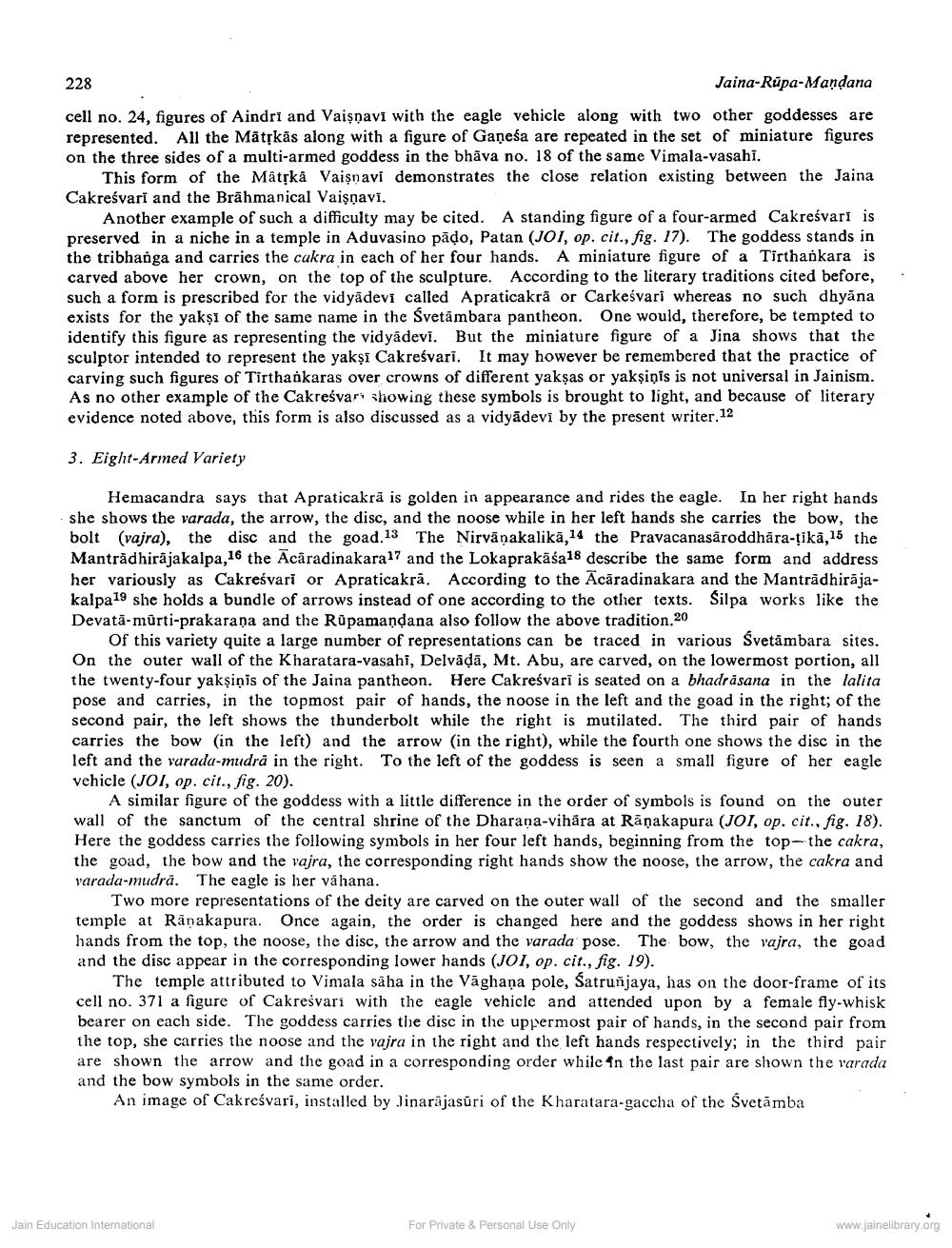________________
228
Jaina-Rupa-Mandana
cell no. 24, figures of Aindri and Vaişpavi with the eagle vehicle along with two other goddesses are represented. All the Mātskās along with a figure of Ganeša are repeated in the set of miniature figures on the three sides of a multi-armed goddess in the bhäva no. 18 of the same Vimala-vasahi.
This form of the Måtļkā Vaisnavi demonstrates the close relation existing between the Jaina Cakreśvari and the Brāhmanical Vaisnavi.
Another example of such a difficulty may be cited. A standing figure of a four-armed Cakreśvari is preserved in a niche in a temple in Aduvasino pādo, Patan (JOT, op. cit., fig. 17). The goddess stands in the tribhanga and carries the cakra in each of her four hands. A miniature figure of a Tirthankara is carved above her crown, on the top of the sculpture. According to the literary traditions cited before, such a form is prescribed for the vidyādevi called Apraticakrā or Carkeśvari whereas no such dhyāna exists for the yakşi of the same name in the Svetāmbara pantheon. One would, therefore, be tempted to identify this figure as representing the vidyādevi. But the miniature figure of a Jina shows that the sculptor intended to represent the yakşi Cakreśvari. It may however be remembered that the practice of carving such figures of Tirtha okaras over crowns of different yakşas or yaksinis is not universal in Jainism. As no other example of the Cakreśvar showing these symbols is brought to light, and because of literary evidence noted above, this form is also discussed as a vidyādevi by the present writer.12
3. Eight-Armed Variety
Hemacandra says that Apraticakra is golden in appearance and rides the eagle. In her right hands she shows the varada, the arrow, the disc, and the noose while in her left hands she carries the bow, the bolt (vajra), the disc and the goad.13 The Nirvāņakalikā, 14 the Pravacanasāroddhāra-ţikā, 15 the Manträdhirajakalpa, 16 the Acaradinakara17 and the Lokaprakāśa18 describe the same form and address her variously as Cakreśvari or Apraticakrā. According to the Acāradinakara and the Manträdhirājakalpa 19 she holds a bundle of arrows instead of one according to the other texts. Silpa works like the Devatā-murti-prakarana and the Rūpamandana also follow the above tradition 20
of this variety quite a large number of representations can be traced in various Svetămbara sites. On the outer wall of the Kharatara-vasahi, Delvādā, Mt. Abu, are carved, on the lowermost portion, all the twenty-four yakşinis of the Jaina pantheon. Here Cakreśvari is seated on a bhadrâsana in the lalita pose and carries, in the topmost pair of hands, the noose in the left and the goad in the right; of the second pair, the left shows the thunderbolt while the right is mutilated. The third pair of hands carries the bow in the left) and the arrow in the right), while the fourth one shows the disc in the left and the varada-mudra in the right. To the left of the goddess is seen a small figure of her eagle vehicle (JOI, op. cit., fig. 20).
A similar figure of the goddess with a little difference in the order of symbols is found on the outer wall of the sanctum of the central shrine of the Dharana-vihara at Ránakapura (JOI, op. cit., fig. 18). Here the goddess carries the following symbols in her four left hands, beginning from the top-the cakra, the goad, the bow and the vajra, the corresponding right hands show the noose, the arrow, the cakra and varada-mudra. The eagle is her vähana.
Two more representations of the deity are carved on the outer wall of the second and the smaller temple at Rånakapura. Once again, the order is changed here and the goddess shows in her right hands from the top, the noose, the disc, the arrow and the varada pose. The bow, the vajra, the goad and the disc appear in the corresponding lower hands (JOI, op. cit., fig. 19).
The temple attributed to Vimala säha in the Våghaņa pole, Satrunjaya, has on the door-frame of its cell no. 371 a figure of Cakreśvari with the eagle vehicle and attended upon by a female fly-whisk bearer on each side. The goddess carries the disc in the uppermost pair of hands, in the second pair from the top, she carries the noose and the vajra in the right and the left hands respectively; in the third pair are shown the arrow and the goad in a corresponding order while in the last pair are shown the varada and the bow symbols in the same order.
An image of Cakreśvari, installed by Jinarajasuri of the Kharatara-gaccha of the Svetāmba
Jain Education International
For Private & Personal Use Only
www.jainelibrary.org




